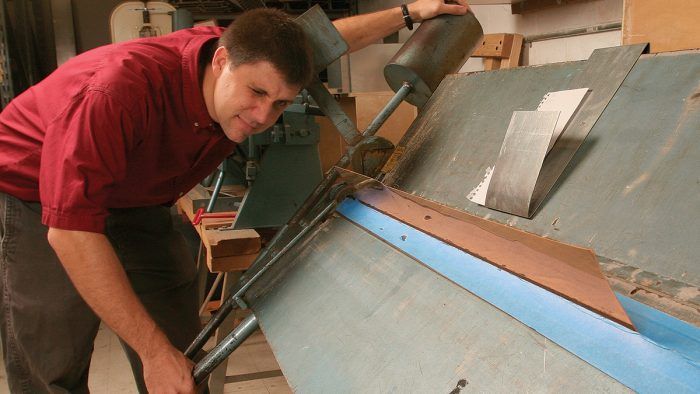Bending Copper Chimney Flashing
Bend flashing parts on a metal brake ahead of time.

When my roofing company flashes a chimney, we save time on the roof and make our lives easier by bending the various flashing parts ahead of time on a metal brake. We use a brake rather than bend by hand because it gives the flashing crisp, straight bends that look and perform better than the somewhat wrinkly bends of hand-formed chimney flashing.
When I make flashing parts, I prefer to use our company’s spacious metal shop. The room’s bright lights and large worktable make it easier to move and lay out the pieces. When you’re looking for a space to lay out and cut sheet metal, look for a place large enough to allow you to rotate the longest lengths of flashing that you’ll be using. It’s also smart to spend some time setting up a good-size worktable, even if it’s just a scrap of plywood on sawhorses.
Our metal shop has a large stationary brake, but we also use portable brakes that we carry in the back of our vans. The layout and bending techniques are the same for both tools. The least expensive 8-ft. and 10-ft. portable brakes common on roofing and siding jobs cost hundreds of dollars, but they are available at rental yards and many home centers for about $50 per day. If you’re bending only smaller pieces, you can buy a smaller brake for about $300.
We use 16-oz. copper for most of our residential flashing work. We like copper’s malleability, and we like that it’s easy to solder. Prepared correctly, copper flashing shouldn’t need attention for decades. We generally pay about $150 for a 3-ft. by 10-ft. sheet, although the price fluctuates.
When you’re bending any type of flashing, the first step is to cut the material to length and width. Our shop has a large shear that I use for cutting the stock to width, but you also can use snips. I like aviation snips for hand-cutting because they require less effort than traditional tin snips. Use care when handling the stock, because cut edges can be extremely sharp. Make the pieces longer than you need, and cut them to exact size on the roof.
Once the piece is cut to size, I lay out the various bends on the flat stock. I mark the bends by measuring from one side of the flashing only so that any slight discrepancy in the width will be hidden by a hemmed edge. Some flashing profiles involve flipping the flashing stock multiple times for bends in opposite directions, so I mark the bends on both ends of the flashing with a hammer and a dull punch. The resulting dimple shows on both sides of the stock, saving time and reducing the number of mistakes.
Once I’ve marked the stock, I plan the order and the direction of the bends so that I don’t crush or distort the flashing piece while I make additional bends. You can see how the pieces go together and how our company flashes a chimney in “Time-Tested Approach to Chimney Flashing.”
Step by Step
1. Cut the stock. Copper generally comes in 3-ft.-wide by 8-ft.-long sheets. Begin by marking the stock with a nail or a scratch awl so that the mark won’t rub off. Then cut the stock to width and length with aviation snips. The length can’t exceed the length of the brake. Copper is expensive, so plan cuts for minimal waste.
 |
 |
2. Mark the bends. Use a hammer and a dull punch to mark the various bends on both ends of the stock. The resulting dimple can be seen on both sides of the stock for making bends in either direction. Marking all the bends at once saves time.
3. Eye the angle. Underbend the flashing pieces so that they hold tight to the roof. Copper flashing can be opened or closed by hand for the perfect fit. Aluminum and steel flashing are less malleable.
 |
 |
4. Hem the edge. Exposed flashing edges should have a 1⁄2-in. hem for a neat appearance and greater strength. Bend the stock as far as the brake allows, and then flatten the bend by closing the brake’s jaws.
Tools for bending metal
Portable metal brakes cost hundreds of dollars. If you need a brake infrequently, you can rent one at most rental yards and many home centers for about $50 per day. You also can get local sheet-metal fabricators to bend flashing stock. Many of these shops specialize in ductwork, so inquire if they have copper or aluminum flashing on hand and what it costs. You also can find aluminum flashing and sheet copper at roofing-supply houses.
 |
Malco, MB48 48-in. metal brake
$310 |
 |
Alum-A-Pole, 8-ft. Alum-A Brake
Starting at $1500 |
Four Shapes for Flashing a Chimney
Flashing a masonry chimney involves bending four basic shapes on a metal brake: the apron, on the downslope side; the step flashing, on the sides; the pan, above the chimney; and the counterflashing, covering the vertical leg of the other pieces.
 |
 |
 |
 |
Photos: Patrick McCombe and Dan Thornton
Fine Homebuilding Recommended Products
Fine Homebuilding receives a commission for items purchased through links on this site, including Amazon Associates and other affiliate advertising programs.

Flashing Boot

Roof Jacks

Fall Protection







